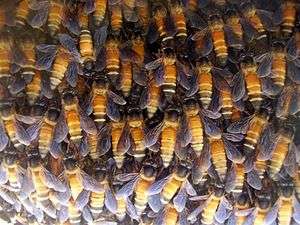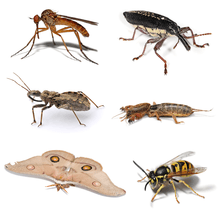Hymenoptera
Hymenoptera is a large order of insects, comprising the sawflies, wasps, bees, and ants. Over 150,000 living species of Hymenoptera have been described,[2][3] in addition to over 2,000 extinct ones.[4]
| Hymenoptera | |
|---|---|
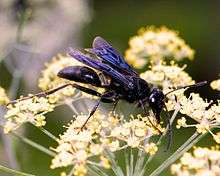 | |
| A digger wasp, Sphex pensylvanicus | |
| Scientific classification | |
| Kingdom: | Animalia |
| Phylum: | Arthropoda |
| Class: | Insecta |
| (unranked): | Endopterygota |
| Superorder: | Hymenopterida |
| Order: | Hymenoptera Linnaeus, 1758 |
| Suborders | |
|
Apocrita | |
Females typically have a special ovipositor for inserting eggs into hosts or places that are otherwise inaccessible. The ovipositor is often modified into a stinger. The young develop through holometabolism (complete metamorphosis)—that is, they have a worm-like larval stage and an inactive pupal stage before they mature.
Etymology
The name Hymenoptera refers to the wings of the insects, but the original derivation is ambiguous.[5]:42 All references agree that the derivation involves the Ancient Greek πτερόν (pteron) for wing.[6] The Ancient Greek ὑμήν (hymen) for membrane provides a plausible etymology for the term because species in this order have membranous wings.[6] However, a key characteristic of this order is that the hind wings are connected to the fore wings by a series of hooks. Thus, another plausible etymology involves Hymen, the Ancient Greek god of marriage, as these insects have "married wings" in flight.
Evolution
The cladogram of external relationships, based on a 2008 DNA and protein analysis, shows the order as a clade, most closely related to endopterygote orders including the Diptera (true flies) and Lepidoptera (butterflies and moths).[7][8][9][10]
| part of Endopterygota |
| ||||||||||||||||||||||||||||||||||||
Hymenoptera originated in the Triassic, with the oldest fossils belonging to the family Xyelidae. Social hymenopterans appeared during the Cretaceous.[11] The evolution of this group has been intensively studied by Alex Rasnitsyn, Michael S. Engel, and others.[12]
This clade has been studied by examining the mitochondrial DNA.[13] Although this study was unable to resolve all the ambiguities in this clade, some relationships could be established. The Aculeata, Ichneumonomorpha, and Proctotrupomorpha were monophyletic. The Megalyroidea and Trigonalyoidea are sister clades as are the Chalcidoidea+Diaprioidea. The Cynipoidea was generally recovered as the sister group to Chalcidoidea and Diaprioidea which are each other's closest relations. The cladogram is based on Schulmeister 2003.[14][15]
| Hymenoptera | |||||||||||||||||||||||||||||||||||||||||||||||
| |||||||||||||||||||||||||||||||||||||||||||||||
| Symphyta (red bar) are paraphyletic as Apocrita are excluded. |
Anatomy
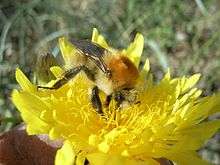
Hymenopterans range in size from very small to large insects, and usually have two pairs of wings. Their mouthparts are adapted for chewing, with well-developed mandibles (ectognathous mouthparts). Many species have further developed the mouthparts into a lengthy proboscis, with which they can drink liquids, such as nectar. They have large compound eyes, and typically three simple eyes, ocelli.
The forward margin of the hind wing bears a number of hooked bristles, or "hamuli", which lock onto the fore wing, keeping them held together. The smaller species may have only two or three hamuli on each side, but the largest wasps may have a considerable number, keeping the wings gripped together especially tightly. Hymenopteran wings have relatively few veins compared with many other insects, especially in the smaller species.
In the more ancestral hymenopterans, the ovipositor is blade-like, and has evolved for slicing plant tissues. In the majority, however, it is modified for piercing, and, in some cases, is several times the length of the body. In some species, the ovipositor has become modified as a stinger, and the eggs are laid from the base of the structure, rather than from the tip, which is used only to inject venom. The sting is typically used to immobilise prey, but in some wasps and bees may be used in defense.[16]
Hymenopteran larvae typically have a distinct head region, three thoracic segments, and usually nine or 10 abdominal segments. In the suborder Symphyta, the larvae resemble caterpillars in appearance, and like them, typically feed on leaves. They have large chewing mandibles, three pairs of thoracic limbs, and, in most cases, six or eight abdominal prolegs. Unlike caterpillars, however, the prolegs have no grasping spines, and the antennae are reduced to mere stubs. Symphytan larvae that are wood borers or stem borers have no abdominal legs and the thoracic legs are smaller than those of non-borers.
With rare exceptions larvae of the suborder Apocrita have no legs and are maggotlike in form, and are adapted to life in a protected environment. This may be the body of a host organism, or a cell in a nest, where the adults will care for the larva. In parasitic forms, the head is often greatly reduced and partially withdrawn into the prothorax (anterior part of the thorax). Sense organs appear to be poorly developed, with no ocelli, very small or absent antennae, and toothlike, sicklelike, or spinelike mandibles. They are also unable to defecate until they reach adulthood due to having an incomplete digestive tract (a blind sac), presumably to avoid contaminating their environment.[16] The larvae of stinging forms (Aculeata) generally have 10 pairs of spiracles, or breathing pores, whereas parasitic forms usually have nine pairs present.[17]
Reproduction
Sex determination
Among most or all hymenopterans, sex is determined by the number of chromosomes an individual possesses.[18] Fertilized eggs get two sets of chromosomes (one from each parent's respective gametes) and develop into diploid females, while unfertilized eggs only contain one set (from the mother) and develop into haploid males. The act of fertilization is under the voluntary control of the egg-laying female, giving her control of the sex of her offspring.[16] This phenomenon is called haplodiploidy.
However, the actual genetic mechanisms of haplodiploid sex determination may be more complex than simple chromosome number. In many Hymenoptera, sex is actually determined by a single gene locus with many alleles.[18] In these species, haploids are male and diploids heterozygous at the sex locus are female, but occasionally a diploid will be homozygous at the sex locus and develop as a male, instead. This is especially likely to occur in an individual whose parents were siblings or other close relatives. Diploid males are known to be produced by inbreeding in many ant, bee, and wasp species. Diploid biparental males are usually sterile but a few species that have fertile diploid males are known.[19]
One consequence of haplodiploidy is that females on average actually have more genes in common with their sisters than they do with their own daughters. Because of this, cooperation among kindred females may be unusually advantageous, and has been hypothesized to contribute to the multiple origins of eusociality within this order.[16][20] In many colonies of bees, ants, and wasps, worker females will remove eggs laid by other workers due to increased relatedness to direct siblings, a phenomenon known as worker policing.[21]
Another consequence is that hymenopterans may be more resistant to the deleterious effects of inbreeding. As males are haploid, any recessive genes will automatically be expressed, exposing them to natural selection. Thus, the genetic load of deleterious genes is purged relatively quickly.[22]
Thelytoky
Some hymenopterans take advantage of parthenogenesis, the creation of embryos without fertilization. Thelytoky is a particular form of parthenogenesis in which female embryos are created (without fertilisation). The form of thelytoky in hymenopterans is a kind of automixis in which two haploid products (proto-eggs) from the same meiosis fuse to form a diploid zygote. This process tends to maintain heterozygosity in the passage of the genome from mother to daughter. It is found in several ant species including the desert ant Cataglyphis cursor,[23] the clonal raider ant Cerapachys biroi,[24] the predaceous ant Platythyrea punctata,[25] and the electric ant (little fire ant) Wasmannia auropunctata.[26] It also occurs in the Cape honey bee Apis mellifera capensis.[27]
Oocytes that undergo automixis with central fusion often have a reduced rate of crossover recombination, which helps to maintain heterozygosity and avoid inbreeding depression. Species that display central fusion with reduced recombination include the ants Platythyrea punctata[25] and Wasmannia auropunctata[26] and the honey bee Apis mellifera capensis.[27] In A. m. capensis, the recombination rate during meiosis is reduced more than tenfold.[27] In W. auropunctata the reduction is 45 fold.[26]
Single queen colonies of the narrow headed ant Formica exsecta illustrate the possible deleterious effects of increased homozygosity. Colonies of this species which have more homozygous queens will age more rapidly, resulting in reduced colony survival.[28]
Diet
Different species of Hymenoptera show a wide range of feeding habits. The most primitive forms are typically herbivorous, feeding on leaves or pine needles. Stinging wasps are predators, and will provision their larvae with immobilised prey, while bees feed on nectar and pollen.
A huge number of species are parasitoids as larvae. The adults inject the eggs into a host, which they begin to consume after hatching. For example, the eggs of the endangered Papilio homerus are parasitized at a rate of 77%, mainly by Hymenoptera species.[29] Some species are even hyperparasitoid, with the host itself being another parasitoid insect. Habits intermediate between those of the herbivorous and parasitoid forms are shown in some hymenopterans, which inhabit the galls or nests of other insects, stealing their food, and eventually killing and eating the occupant.[16]
Classification
.jpg)
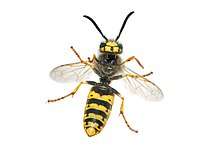
The Hymenoptera are divided into two groups; the Symphyta which have no waist, and the Apocrita which have a narrow waist.[30]
Symphyta
The suborder Symphyta includes the sawflies, horntails, and parasitic wood wasps. The group may be paraphyletic, as it has been suggested that the family Orussidae may be the group from which the Apocrita arose. They have an unconstricted junction between the thorax and abdomen. The larvae are herbivorous, free-living, and eruciform, with three pairs of true legs, prolegs (on every segment, unlike Lepidoptera) and ocelli. The prolegs do not have crochet hooks at the ends unlike the larvae of the Lepidoptera.[30]
Apocrita
The wasps, bees, and ants together make up the suborder (and clade) Apocrita, characterized by a constriction between the first and second abdominal segments called a wasp-waist (petiole), also involving the fusion of the first abdominal segment to the thorax. Also, the larvae of all Apocrita lack legs, prolegs, or ocelli. The hindgut of the larvae also remains closed during development, with feces being stored inside the body, with the exception of some bee larvae where the larval anus has reappeared through developmental reversion. In general, the anus only opens at the completion of larval growth.[30]
See also
- Hymenoptera genome database
- Insects in literature (ant, bee, wasp)
- Worker policing
References
- Ronquist, Fredrik; Klopfstein, Seraina; Vilhelmsen, Lars; Schulmeister, Susanne; Murray, Debra L.; Rasnitsyn, Alexandr P. (December 2012). "A Total-Evidence Approach to Dating with Fossils, Applied to the Early Radiation of the Hymenoptera". Systematic Biology. 61 (6): 973–999. doi:10.1093/sysbio/sys058. PMC 3478566. PMID 22723471.
- Mayhew, Peter J. (2007). "Why are there so many insect species? Perspectives from fossils and phylogenies". Biological Reviews. 82 (3): 425–454. doi:10.1111/j.1469-185X.2007.00018.x. PMID 17624962.
- Janke, Axel; Klopfstein, Seraina; Vilhelmsen, Lars; Heraty, John M.; Sharkey, Michael; Ronquist, Fredrik (2013). "The Hymenopteran Tree of Life: Evidence from Protein-Coding Genes and Objectively Aligned Ribosomal Data". PLoS ONE. 8 (8): e69344. Bibcode:2013PLoSO...869344K. doi:10.1371/journal.pone.0069344. PMC 3732274. PMID 23936325.
- Aguiar, Alexandre P.; Deans, Andrew R.; Engel, Michael S.; Forshage, Mattias; Huber, John T.; et al. (30 August 2013). "Order Hymenoptera". In Zhang, Z.-Q. (ed.). Animal Biodiversity: An Outline of Higher-level Classification and Survey of Taxonomic Richness (Addenda 2013). Zootaxa. 3703. p. 51. doi:10.11646/zootaxa.3703.1.12.
- Grissell, Eric (2010). Bees, Wasps, and Ants: The Indispensable Role of Hymenoptera in Gardens. Timber Press.
- Carpenter, George Herbert (1911). . In Chisholm, Hugh (ed.). Encyclopædia Britannica. 14 (11th ed.). Cambridge University Press. p. 177.
- Whiting, Michael F.; Whiting, Alison S.; Hastriter, Michael W.; Dittmar, Katharina (2008). "A molecular phylogeny of fleas (Insecta: Siphonaptera): origins and host associations". Cladistics. 24 (5): 677–707. CiteSeerX 10.1.1.731.5211. doi:10.1111/j.1096-0031.2008.00211.x.
- Yeates, David K.; Wiegmann, Brian. "Endopterygota Insects with complete metamorphosis". Tree of Life. Retrieved 24 May 2016.
- Whiting, Michael F. (2002). "Mecoptera is paraphyletic: multiple genes and phylogeny of Mecoptera and Siphonaptera". Zoologica Scripta. 31 (1): 93–104. doi:10.1046/j.0300-3256.2001.00095.x. Archived from the original on 2013-01-05.
- Wiegmann, Brian; Yeates, David K. (2012). The Evolutionary Biology of Flies. Columbia University Press. p. 5. ISBN 978-0-231-50170-5.
- Hoell, H.V.; Doyen, J.T.; Purcell, A.H. (1998). Introduction to Insect Biology and Diversity (2nd ed.). Oxford University Press. p. 320. ISBN 978-0-19-510033-4.
- Peters, Ralph S.; Krogmann, Lars; Mayer, Christoph; Donath, Alexander; Gunkel, Simon; Meusemann, Karen; Kozlov, Alexey; Podsiadlowski, Lars; Petersen, Malte (April 2017-04). "Evolutionary History of the Hymenoptera". Current Biology. 27 (7): 1013–1018. doi:10.1016/j.cub.2017.01.027. PMID 28343967. Check date values in:
|date=(help) - Mao M, Gibson T, Dowton M (2014) Higher-level phylogeny of the Hymenoptera inferred from mitochondrial genomes. Mol Phylogenet Evol
- Schulmeister, S. (2003). "Simultaneous analysis of basal Hymenoptera (Insecta), introducing robust-choice sensitivity analysis". Biological Journal of the Linnean Society. 79 (2): 245–275. doi:10.1046/j.1095-8312.2003.00233.x.
- Schulmeister, S. "Symphyta". Retrieved 28 November 2016.
- Hoell, H.V.; Doyen, J.T.; Purcell, A.H. (1998). Introduction to Insect Biology and Diversity (2nd ed.). Oxford University Press. pp. 570–579. ISBN 978-0-19-510033-4.
- Hunt, James H. (2007). The Evolution of Social Wasps. Oxford University Press, USA. p. 12. ISBN 978-0-19-804207-5.
- David P. Cowan; Julie K. Stahlhut (13 July 2004). "Functionally reproductive diploid and haploid males in an inbreeding hymenopteran with complementary sex determination". PNAS. 101 (28): 10374–10379. Bibcode:2004PNAS..10110374C. doi:10.1073/pnas.0402481101. PMC 478579. PMID 15232002.
- Elias, J.; Mazzi, D.; Dorn, S. (2009). Bilde, Trine (ed.). "No Need to Discriminate? Reproductive Diploid Males in a Parasitoid with Complementary Sex Determination". PLoS ONE. 4 (6): e6024. Bibcode:2009PLoSO...4.6024E. doi:10.1371/journal.pone.0006024. PMC 2696080. PMID 19551142.
- Quiñones, Andrés E.; Pen, Ido (June 2017). "A unified model of Hymenopteran preadaptations that trigger the evolutionary transition to eusociality". Nature Communications. 8: 15920. doi:10.1038/ncomms15920. PMC 5490048. PMID 28643786.
- Davies, N.R.; Krebs, J.R.; and West, S.A. An Introduction to Behavioral Ecology. 4th ed. West Sussex: Wiley-Blackwell, 2012. pp. 387–388
- LaSalle, John; David, Gauld, Ian (1993). Hymenoptera and biodiversity. C.A.B. International. ISBN 978-0851988306. OCLC 28576921.
- Pearcy, M.; Aron, S.; Doums, C.; Kelle, L. (2004). "Conditional use of sex and parthenogenesis for worker and queen production in ants" (PDF). Science. 306 (5702): 1780–3. Bibcode:2004Sci...306.1780P. doi:10.1126/science.1105453. PMID 15576621.
- Oxley, P. R.; Ji, L.; Fetter-Pruneda, I.; McKenzie, S. K.; Li, C.; Hu, H.; Zhang, G.; Kronauer, D. J. (2014). "The genome of the clonal raider ant Cerapachys biroi". Curr. Biol. 24 (4): 451–8. doi:10.1016/j.cub.2014.01.018. PMC 3961065. PMID 24508170.
- Kellner, Katrin; Heinze, Jürgen (2011). "Mechanism of facultative parthenogenesis in the ant Platythyrea punctata". Evolutionary Ecology. 25: 77–89. doi:10.1007/s10682-010-9382-5.
- Rey, O.; Loiseau, A.; Facon, B.; Foucaud, J.; Orivel, J.; Cornuet, J. M.; Robert, S.; Dobigny, G.; Delabie, J. H.; Mariano Cdos, S.; Estoup, A. (2011). "Meiotic recombination dramatically decreased in thelytokous queens of the little fire ant and their sexually produced workers". Mol. Biol. Evol. 28 (9): 2591–601. doi:10.1093/molbev/msr082. PMID 21459760.
- Baudry, E.; Kryger, P.; Allsopp, M.; Koeniger, N.; Vautrin D.; Mougel F.; Cornuet JM.; Solignac M. (2004). "Whole-genome scan in the lytokous-laying workers of the Cape honeybee (Apis mellifera capensis): central fusion, reduced recombination rates and centromere mapping using half-tetrad analysis". Genetics. 167 (1): 243–252. doi:10.1534/genetics.167.1.243. PMC 1470879. PMID 15166151.
- Haag-Liautard C, Vitikainen E, Keller L, Sundström L (2009). "Fitness and the level of homozygosity in a social insect" (PDF). J. Evol. Biol. 22 (1): 134–142. doi:10.1111/j.1420-9101.2008.01635.x. PMID 19127611.
- Lehnert, Matthew S.; Kramer, Valerie R.; Rawlins, John E.; Verdecia, Vanessa; Daniels, Jaret C. (2017-07-10). "Jamaica's Critically Endangered Butterfly: A Review of the Biology and Conservation Status of the Homerus Swallowtail (Papilio (Pterourus) homerus Fabricius)". Insects. 8 (3): 68. doi:10.3390/insects8030068. PMC 5620688. PMID 28698508.
- Aguiar, A.P.; Deans, A.R.; Engel, M.S.; Forshage, M.; Huber, J.T.; Jennings, J.T.; Johnson, N.F.; Lelej, A.S.; Longino, J.T.; Lohrmann, V.; Mikó, I.; Ohl, M.; Rasmussen, C.; Taeger, A.; Yu, D.S.K. (2013). "Order Hymenoptera Linnaeus, 1758. In: Zhang, Z.-Q. (Ed.) Animal Biodiversity: An Outline of Higher-level Classification and Survey of Taxonomic Richness (Addenda 2013)". Zootaxa. 3703: 1–82. doi:10.11646/zootaxa.3703.1.12. PMID 26146682.
Bibliography
- Aguiar, Alexandre P.; Deans, Andrew R.; Engel, Michael S.; Forshage, Mattias; Huber, John T.; Jennings, John T.; Johnson, Norman F.; Lelej, Arkady S.; Longino, John T.; Lohrmann, Volker; Mikó, István; Ohl, Michael; Rasmussen, Claus; Taeger, Andreas; Yu, Dicky Sick Ki (30 August 2013). "Order Hymenoptera". Zootaxa. 3703 (1): 51–62. doi:10.11646/zootaxa.3703.1.12. PMID 26146682., in Zhang, Z.-Q. (ed.) Animal Biodiversity: An Outline of Higher-level Classification and Survey of Taxonomic Richness (Addenda 2013)
- Capinera, John L., ed. (2008). Encyclopedia of Entomology (2nd ed.). Dordrecht: Springer. ISBN 978-1-4020-6242-1.CS1 maint: ref=harv (link)
- Carus, Julius Victor; Gerstaecker, C.E.A., eds. (1863). Handbuch der zoologie. Zweiter Band. Leipzig: Engelmann.CS1 maint: ref=harv (link)
- Dallas, W.S. (1867). Insecta. pp. 195–484., in Günther (1867)
- Dowton, M.; Austin, A. D. (11 October 1994). "Molecular phylogeny of the insect order Hymenoptera: apocritan relationships". Proceedings of the National Academy of Sciences. 91 (21): 9911–9915. Bibcode:1994PNAS...91.9911D. doi:10.1073/pnas.91.21.9911. PMC 44927. PMID 7937916.CS1 maint: ref=harv (link)
- Gerstaecker, A (July 1867). "Ueber die Gattung Oxybelus Latr. und die bei Berlin vorkommenden Arten derselben". Zeitschrift für die Gesammten Naturwissenschaft. 30 (VII): 1–144.CS1 maint: ref=harv (link)
- Goulet, Henri; Huber, John T., eds. (1993). Hymenoptera of the world: An identification guide to families (PDF). Ottawa: Agriculture Canada. ISBN 978-0-660-14933-2. Archived from the original (PDF) on 2016-03-05.
- Gullan, P. J.; Cranston, P. S. (2014). The Insects: An Outline of Entomology (Fifth ed.). Wiley Blackwell.
- Günther, A.C.L.G., ed. (1867). The Record of Zoological Literature vol. iv. London: van Voorst.CS1 maint: ref=harv (link) (see The Record of Zoological Literature)
- Grimaldi, D.; Engel, M.S. (2005). Evolution of the Insects. Cambridge University Press. ISBN 978-0-521-82149-0.
- Hennig, Willi (1969). Die Stammesgeschichte der Insekten. Frankfurt: Waldemar Kramer.CS1 maint: ref=harv (link)
- Mao, Meng; Gibson, Tracey; Dowton, Mark (March 2015). "Higher-level phylogeny of the Hymenoptera inferred from mitochondrial genomes". Molecular Phylogenetics and Evolution. 84: 34–43. doi:10.1016/j.ympev.2014.12.009. PMID 25542648.
- Rasnitsyn, A.P.; Quicke, D.L.J. (2002). History of Insects. Kluwer Academic Publishers. pp. 242–254. ISBN 978-1-4020-0026-3.
- Rasnitsyn, A.P. (1988). "An outline of evolution of hymenopterous insects (order Vespida)". Oriental Insects. 22: 115–145. doi:10.1080/00305316.1988.11835485.CS1 maint: ref=harv (link)
- Seltmann, Katja Chantre (December 2004). Building web-based interactive keys to the hymenopteran families and superfamilies (PDF). College of Agriculture, University of Kentucky. Archived from the original (M. Sc. Thesis) on 3 December 2011.
- Sharkey, Michael J (2007). "Phylogeny and Classification of Hymenoptera" (PDF). Zootaxa. 1668: 521–548. doi:10.11646/zootaxa.1668.1.25.CS1 maint: ref=harv (link)
- Sharkey, Michael J.; Carpenter, James M.; Vilhelmsen, Lars; Heraty, John; Liljeblad, Johan; Dowling, Ashley P.G.; Schulmeister, Susanne; Murray, Debra; Deans, Andrew R.; Ronquist, Fredrik; Krogmann, Lars; Wheeler, Ward C. (February 2012). "Phylogenetic relationships among superfamilies of Hymenoptera". Cladistics. 28 (1): 80–112. CiteSeerX 10.1.1.721.8852. doi:10.1111/j.1096-0031.2011.00366.x.
- Song, Sheng-Nan; Tang, Pu; Wei, Shu-Jun; Chen, Xue-Xin (16 February 2016). "Comparative and phylogenetic analysis of the mitochondrial genomes in basal hymenopterans". Scientific Reports. 6: 20972. Bibcode:2016NatSR...620972S. doi:10.1038/srep20972. PMC 4754708. PMID 26879745.
External links
| Wikimedia Commons has media related to Hymenoptera. |
| Wikispecies has information related to Hymenoptera |
| Look up Hymenoptera in Wiktionary, the free dictionary. |
- General
- Hymenoptera Anatomy Ontology project
- Hymenoptera Anatomy Glossary
- Hymenoptera Forum German and International
- Hymenoptera of North America – large format reference photographs, descriptions, taxonomy
- International Society of Hymenopterists
- Bees, Wasps and Ants Recording Society (UK)
- Ants Photo Gallery (RU)
- Sphecos Forum for Aculeate Hymenopterra
- Hymenoptera images on MorphBank, a biological image database
- Order Hymenoptera Insect Life Forms
- Systematics
- Hymenopteran Systematics
- Hymenoptera Online 1000+ images
- Regional Lists
- Insetos do Brasil
- New Zealand Hymenoptera
- Waspweb Afrotropical Hymenoptera Excellent images
- checklist of Australian Hymenoptera
- Books



